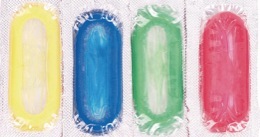-
General Health Conditions







Sexually Transmitted Infections (STIs)
Sexually transmitted infections (STIs) are ones that pass from one person to another through sexual contact. This can be from vaginal, anal, or oral sex, and from genital-to-genital contact. STIs are also called sexually transmitted diseases (STDs).
Common STIs in the U.S. are:
-
•Chlamydia.
-
•Genital herpes.
-
•Gonorrhea.
-
•Hepatitis B.
-
•HIV/AIDS.
-
•Human papillomavirus (HPV). This causes genital warts.
-
•Trichomoniasis.
-
•Syphilis.

















Condoms reduce the risk of HIV and some STIs.
Discuss “safer sex” with a partner before having sex.

-
•Latex and polyurethane condoms can help reduce the risk of spreading HIV and other STIs (i.e., chlamydia, gonorrhea, and trichomoniasis). To do this, they must be used the right way for every sex act. They do not get rid of the risk entirely. Barriers made of natural membranes, such as from lamb, do not give good protection against STIs.
-
•Females and males should use latex or polyurethane condoms every time they have genital-to-genital contact and/or oral sex. Use polyurethane condoms if either partner is allergic to latex. You don’t need condoms to prevent STIs if you have sex only with one partner and neither of you has an STI.
-
•For oral-vaginal sex and oral-anal sex, use latex dams (“doilies”). These are latex squares.
-
•Latex condoms with spermicides, such as nonoxynol-9 (N–9) are no better than other lubricated condoms for preventing HIV/STIs. Spermicides with N–9 do not prevent chlamydia, cervical gonorrhea, or HIV. Don’t use spermicides alone to prevent HIV/STIs. Using spermicides with N–9 often has been linked with genital lesions which may increase the risk of spreading HIV. Also, N–9 may increase the risk of spreading HIV during anal intercourse.

-
•Use water-based lubricants, such as K-Y Brand Jelly. Don’t use oil-based or “petroleum” ones, such as Vaseline. They can damage latex barriers.
-
•To lower your risk for HPV, use latex or polyurethane condoms. These work best at covering areas of the body that HPV is most likely to affect. A diaphragm does not prevent the spread of HPV.
-
•Don’t have sex while under the influence of drugs or alcohol. You are less likely to use “safer sex” measures.
-
•Limit sexual partners. Sexual contact with many persons increases the risk for STIs, especially if no protection is used.
-
•Discuss a new partner’s sexual history with him or her before you start having sex. Know that persons are not always honest about their sexual past.
-
•Avoid sexual contact with persons whose health status and health practices are not known.
-
•Follow your doctor’s advice to check for STIs.
To Treat STIs
Medical care is needed for STIs. With medical care, do the self-care measures that follow.
For Genital Herpes
-
•If prescribed an oral antiviral medicine, take it as advised.
-
•Bathe the affected area twice a day with mild soap and water. Pat dry with a towel or use a hair dryer set on warm. Using a colloidal oatmeal soap or bath may be soothing.
-
•Use a sitz bath to soak the affected area. You can buy a sitz bath basin from a medical supply or drug store.
-
•Apply ice packs on the affected genital area for 5 to 10 minutes to relieve itching and swelling.
-
•Wear loose-fitting pants or skirts. Don’t wear pantyhose. Wear cotton (not nylon) underwear.
-
•If pain is made worse when you urinate, squirt tepid water near the urinary opening while you pass urine. Or, urinate while using a sitz bath.
-
•Take a mild pain reliever as directed.
-
•Ask your doctor about using a local anesthetic ointment, such as lidocaine, during the most painful part of an outbreak.
-
•Wash your hands if you touch the blisters or sores. Don’t touch your eyes during an outbreak. Doing this could spread the virus to your eyes.
-
•To help avoid spreading the virus to others, use latex barriers during sex and skin-to-skin contact.
For HPV
-
•If you are female, don’t smoke. If you smoke, quit.
-
•A vaccine for HPV is advised for girls 11 to 12 years of age, but can be given to females from age 9 to age 26.
For Trichomoniasis
-
•Don’t drink alcohol for 24 hours before, during, and 24 hours after taking metronidazole. The combination causes vomiting, dizziness, and headaches.
Chlamydia
Signs & Symptoms
For Females
75% of females have few or no symptoms, but can still transmit the infection. When present, symptoms show up 2 to 4 weeks after infection. They include:
-
•Slight yellowish-green vaginal discharge. Abnormal vaginal bleeding.
-
•Vaginal irritation or pain.
-
•Need to urinate often and pain or burning feeling when passing urine.
-
•Pain in the abdomen.
In females, chlamydia can cause pelvic inflammatory disease (PID). This can cause infertility.
For Males
25% of males have few or no symptoms. When present, symptoms show up 2 to 4 weeks after infection. They include:
-
•Watery, mucous discharge from the penis.
-
•Burning or discomfort when passing urine.
-
•Pain in the scrotum.
Causes
A specific bacterial infection.
Treatment
-
•Oral antibiotics for the infected person and his or her partner(s).
-
•Avoiding sex until treatment is finished in the infected person and his or her partner(s).
Genital Herpes
Signs & Symptoms
For Females and Males
-
•Painful sores and/or blisters on the genital area, anus, thighs, and/or buttocks.
-
•Itching, irritation, and tingling can occur 1 to 2 days before the outbreak of the blisters.
-
•Outbreaks may be triggered by stress, other illnesses, and vigorous sexual intercourse.
After a few days, the blisters break open and leave painful, shallow ulcers. These can last from 5 days to 3 weeks. With outbreaks, especially the first one, there may be flu-like symptoms (swollen glands, fever, body aches). Outbreaks that follow are usually milder and shorter.
Causes
-
•Herpes simplex virus (HSV-1 or HSV-2). Either one can cause genital herpes. HSV-2 is the common cause. HSV-1 most often affects the oral area as cold sores.
-
•The virus is spread by direct skin-to-skin contact from the site of infection to the contact site. It can also be spread when no symptoms are noticed. Oral sex can spread herpes from the mouth to the genital area and from the genital area to the mouth.
Treatment
-
•There is no cure. Antiviral medicines can help prevent outbreaks and shorten how long they last.
-
•Self-care measures. (See To Treat STIs, For Genital Herpes below.)
Gonorrhea
Signs & Symptoms
For Females
Sixty to 80% of females have no symptoms. If present, they appear in 2 to 10 days and include:
-
•Mild vaginal itching and burning. Thick, yellow-green vaginal discharge.
-
•Burning when passing urine.
-
•Severe pain in the lower abdomen.
For Males
Males may have no symptoms, but usually have:
-
•Pain at the tip of the penis. Thick, yellow, cloudy, penile discharge.
-
•Pain and burning when passing urine.
Causes
A specific bacterial infection. If it is not treated, it can spread to joints, tendons, or the heart. In females, it can cause pelvic inflammatory disease (PID). This can cause infertility.
Treatment
-
•Antibiotics.
-
•Pain relievers.
-
•Treating sexual partner(s) to avoid getting infected again.
-
•Follow-up test to find out if the treatment worked.
Human Papillomavirus (HPV)
Signs & Symptoms
In Females and Males
Often, there are no visible signs or symptoms. Genital warts can appear several weeks after being infected or may not show up for months or even years. This makes it hard to know when the virus was acquired and which partner was the carrier. Genital warts:
-
•Can be soft or hard; pink, red, or yellow-gray in color.
-
•Are inside the vagina, on the lips of the vagina, or around the anus in females.
-
•Are on the penis, inside the head of the penis, on the scrotum, or around the anus in males.
Causes
HPV is spread by direct skin-to-skin contact during vaginal, anal, or (rarely) oral sex with an infected partner. Genital warts are not caused by touching warts on the feet, hands, etc.
Treatment
-
•HPV vaccine can prevent cervical cancer and genital warts due to HPV. It is advised for girls 11 to 12 years of age, but can be given to females from age 9 to age 26.
-
•Genital warts can be treated with topical creams or a gel prescribed by a doctor. You apply these yourself. Medical treatments can remove genital warts.
Syphilis
Signs & Symptoms
-
•Primary stage. A large, painless, ulcer-like sore (chancre) appears around the area of sexual contact in 2 to 6 weeks.
-
•Secondary stage. A month later, a widespread skin rash appears on the palms of the hands, soles of the feet, and sometimes around the mouth and nose. The rash has small, red, scaly bumps that do not itch. Other types of rashes, swollen lymph nodes, fever, and flu-like symptoms may also occur. Small patches of hair may fall out of the scalp, beard, eyelashes, and eyebrows.
-
•Latent stage. The infection may go unnoticed for years, but damages the heart, muscles, and other organs and tissues.
Causes
A specific bacterial infection. It can lead to heart failure, blindness, dementia, or death if not treated. {Note: An elderly person with signs of dementia should be evaluated for syphilis.}
Treatment
-
•Antibiotics (usually Penicillin-G given by a shot into the muscle). All persons who have syphilis should be tested for HIV, as advised.
-
•After treatment, follow-up blood tests are needed in 6 and 12 (and possibly 3) months.
-
•Once treatment is complete, you’re no longer contagious, but you can get infected again.
Trichomoniasis
Signs & Symptoms
For Females
Symptoms may not be present for years. If they do occur, symptoms include:
-
•Vaginal itching and burning.
-
•A yellow-green or gray vaginal discharge with an odor.
-
•Burning or pain when passing urine.
-
•Pain during sex.
For Males
Symptoms are not usually present. Males can infect their sexual partners and not know it. When present, symptoms in males include:
-
•Discomfort when passing urine.
-
•Pain during sex.
-
•Irritation and itching of the penis.
Causes
A protozoan.
Treatment
-
•The oral medication metronidazole (Flagyl).
-
•Treating sexual partners to prevent spreading the infection and getting it again.
Questions to Ask
Self-Care / Prevention
Safer Sex To Help Prevent STIs
-
•The only sure way to avoid STIs is not having sex. This includes intercourse, oral sex, anal sex, and genital-to-genital contact. Caressing, hugging, dry kissing, and masturbation are no risk or extremely low-risk practices. So is limiting your sexual contact to one person your entire life. This is if your partner does not have an STI and has sex only with you.
Do sores appear in the genital area only after taking a recently prescribed medicine?
Do you want to rule out an STI because you have had many sex partners and you are starting a new sexual relationship or are planning to get married or pregnant?
Are you symptom-free, but worried that you got an STI from someone you think may have one?
Do you already have a diagnosis of genital herpes and do you have severe pain and blistering and/or are you having outbreaks often?
Do you have signs and symptoms of any of the STIs listed above?



Get more information from:
HealthyLearn® | www.HealthyLearn.com. Click on MedlinePlus®.
American Social Health Association (ASHA) | www.ashastd.org
CDC - Info | 800.CDC.INFO (232.6348) | www.cdc.gov/std




Copyright © 2009, American Institute for Preventive Medicine. All rights reserved.